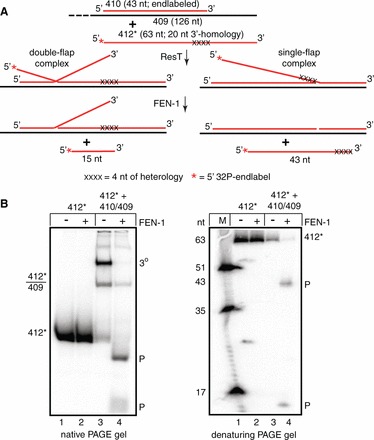Figure 7.

Analysis of the ternary complexes with the 5′-flap endonuclease, FEN-1. (A) Schematic representation of double- or single-flap complex formation by incomplete or blocked strand exchange, respectively, between a 63-nt ssDNA radiolabeled donor (412*) and unlabeled partial duplex target DNA (410/409). The 412* donor oligo has a 4 nt of heterology block at what would be the initial branch point with the partial duplex target DNA (410/409). Treatment with human FEN-1 cleaves off the 5′-flap releasing radiolabeled single-stranded fragments and a smaller unlabeled 3′-single flap complex and a nicked partial duplex product (not visualized on the gels). X represents sequence changes in the donor that introduce mismatches with the target DNA; the asterisk presents the 32P 5′-endlabel. (B) Native and denaturing PAGE analysis of FEN-1 cleavage of deproteinated flap complexes. Strand exchange reactions were set up between 5′-endlabeled 412* donor and unlabeled 410/409 target DNA. Reactions were deproteinated by addition of SDS to a final concentration of 0.1%. The SDS was removed and the buffer was changed by application of the resulting reactions to G-25 Sephadex spin columns for subsequent reaction with 40 nM of human FEN-1 at 37°C for 20 min. The reactions without FEN-1 were treated identically except without the addition of FEN-1 in the final incubation.
